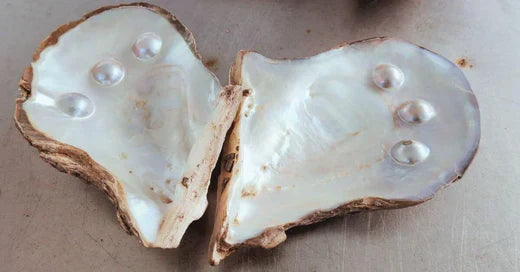Pearls, the lustrous gems born within the sea, have captivated humanity for centuries. From the classic beauty of Akoya to the exotic appeal of Tahitian and South Sea pearl, each has its charm. Yet, among these ocean treasures lies a rare and mysterious find: the embedded pearl. Unlike regular pearls that grow freely, these formations become trapped and integrated into the very structure of the mollusc’s shell.

How Are Pearls Supposed to Form?
Normally, a pearl's creation is a defence mechanism. The process, for both natural and cultured pearls, follows a clear path within the mollusc's soft tissue, not on the shell itself.
- An Irritant Appears: A tiny irritant, like a parasite or a piece of debris, lodges itself within the mollusc's soft mantle tissue. In cultured pearls, this is a bead nucleus inserted by a technician.
- A Pearl Sac Forms: The mollusc protects itself by enveloping the irritant in a sac of epithelial cells.
- Nacre is Secreted: This sac secretes thousands of concentric layers of nacre (mother-of-pearl), which build up over years to form a lustrous, free-growing pearl.
The Anomaly: The Journey of an Embedded Pearl
Embedded pearls begin like any other but take a bizarre turn. They represent a complete deviation from the standard biological process, making them a fascinating aberration.
- Initial Formation: Like a typical pearl, the process starts with an irritant in the soft tissue.
- Unusual Migration: For reasons not yet understood, the developing pearl sac begins to move away from the soft tissue, towards the inner shell.
- Envelopment: As it nears the shell, the mantle—responsible for creating both nacre and shell material—begins to deposit layers of shell around the pearl, effectively encasing and embedding it into the shell's structure.

Embedded Pearls vs. Blister Pearls
While both formations involve the shell, their origins are fundamentally different. It's crucial not to confuse an embedded pearl with a blister pearl.
Embedded Pearls
- Origin: Start as free pearls in the soft tissue, then migrate.
- Integration: Become fully integrated *within* the shell's layers.
- Shape: Often irregular due to the pressure and interaction with the shell.
- Value: Hold no commercial jewellery value but are of great scientific interest.
Blister Pearls
- Origin: Form directly on the inner surface of the shell when an irritant gets trapped there.
- Integration: Attached *to the surface* of the shell, creating a blister-like bump.
- Shape: Hemispherical with a flat back where they attach to the shell.
- Value: Have commercial value. They are often cut from the shell to become Mabe pearls for use in jewellery.
A Scientific Curiosity, Not a Gem
Because they are fused with the shell, embedded pearls cannot be harvested or used in jewellery. They are treasured not for their beauty, but for the questions they raise. Their existence is an enigma that highlights how much we still have to learn about the natural world.
Many questions remain unanswered:
- What triggers the pearl's initial migration towards the shell?
- Is it a random malfunction or a response to a specific factor?
- Are certain genetic or environmental conditions more likely to cause it?
These peculiar formations remind us that nature is not always uniform or predictable. They are a beautiful testament to the rare and fascinating exceptions that challenge our understanding.



